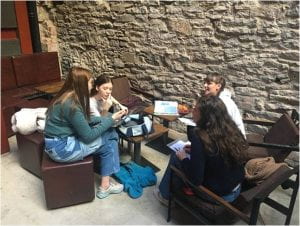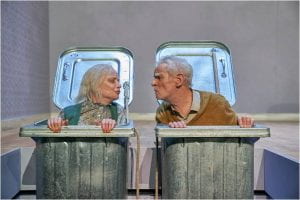This week’s post is written by second year students on the unit Performing the Archive and give an account of the projects they were working on in their groups shortly before the lockdown. They were developing guided tours, audio installations and performance re-enactments in response to stories discovered in the Bristol Old Vic archive, which is held in the University of Bristol Theatre Collection.
These would have been shown to the public at the Bristol Old Vic on March 23, but this was not possible due to the COVID-19 crisis. Here two of the groups have written about the stories from the theatre’s history that they found interesting, their research and creative processes, and what you would have experienced if their showings had been able to go ahead.
Love and Romance at Bristol Old Vic: from love letters to weddings, both on and offstage, exploring the romances of the Old Vic through an interactive audio tour
We are a group of six students from University of Bristol’s Department of Theatre who are currently working on our final project for Performing The Archive. Throughout this unit we have been collaborating closely with the engagement team at Bristol Old Vic to help share the theatre’s history with the city of Bristol. Our group are focusing on a collection of love stories and romances related to the Old Vic.
To us, this theatre represents community and the spirit of Bristol itself. We want to celebrate the love for Bristol Old Vic and the romances that have happened there by creating an audio tour of the building. Unfortunately, due to the current pandemic, we weren’t able to show our project to the public, but we hope to be able to as soon as it is safe.
We have spent the past few months trawling through the archival boxes in the Theatre Collection, uncovering forgotten romances from the past and transcribing 19th century love letters. From audience members, staff, actors and everyone in between, we have worked with a wide range of historical evidence, including these letters, interviews and photographs.
Having learned about the importance of archival practices in the retelling of theatrical history, we have found it truly heart-warming to discover just how many people have romantic stories connected with Bristol Old Vic. We have turned some of these stories from the past into scripts, and then into audio recordings, to create interviews with historical figures such as James Chute and Charlotte Cushman.
For the more recent and first-hand stories, we have been using Bristol Old Vic’s Memory of Theatre recordings. These interviews are part of a heritage project that aims to preserve the public’s memories and experiences of the theatre for future audiences. During this unit we conducted our own Memory of Theatre interviews with regular theatregoers and staff at Bristol Old Vic. We found this medium a lot more personal to work with than some of the information from hundreds of years ago. It was exciting to hear real voices share their stories and we felt it added a lot of charm to our project. It’s even more exciting to think that these people will hear their stories represented in our audio tour when we are able to present it to the public.
We’ll leave you with one of our stories to whet your appetite. In Bristol Old Vic there is a window in Coopers’ Hall lovingly named ‘the proposal window’ and it has a history of romance surrounding it. Duty Manager Andrew Stocker shared with us the story of a proposal that took place there in 1992; it was Valentine’s Day and Bristol Old Vic’s production of Romeo and Juliet was preparing for their evening performance. “Suddenly, as it was coming up to about quarter past sevenâ€, Stocker recalls, “a young man stood up and… went down on one knee to his girlfriend–and out of his pocket pulled a ring and proposed to her!†Stocker continues, “she screamed initially, and then smiled and said yes and everybody clapped. It was very magical and especially on Valentine’s Day!†It later turned out that the young man chose to propose next to this ‘proposal window’ because it was the very spot where his father proposed to his mother in the 1970s.
This is just one of the tales we have discovered, and we can’t wait to share the rest with the public. We hope that these love stories will bring as much joy to you as they have brought to us.
By Stella Parker, on behalf of her Performing the Archive group, Riddhi Bhatt, Kate Bolton, Ed Lyness, Katie Smith, Ruidong Yang.
Dragon’s Den: Theatre Royal edition
Good morning/afternoon/evening, depending on when you’ve decided to read this blog post and learn more about Bristol Old Vic’s history, which we love and hope you will too. We are Theatre students at the University of Bristol and have been exploring the theatre’s archives in the Theatre Collection to learn more about the Old Vic’s past, which we would like to share with you.
Idea
During our research we were particularly gripped by the information regarding the selling of Bristol Old Vic in 1942, and the threat of closure prior to this. We were impacted profoundly by the thought that this theatre, such a part of the heart of Bristol now, was nearly lost for good (and very nearly became a fruit and vegetable warehouse). This information was striking, but in the form of papers and letters it was not particularly accessible or entertaining.
We contemplated how we could make this story relevant to an audience today and decided to re-stage the auction as a pitch on the popular TV show Dragons’ Den. Using the format of this programme allowed us to depict the auction in an inventive way, using the evidence in a manner that a contemporary audience could enjoy and learn from. The challenge of this was staying true to the historical facts while bringing it into our era. We decided to use quotes from the archives so that the language is from the period when the auction occurred, while having modern-day costumes typical of Dragons’ Den suits.
Research
 Happy with our idea, we began our research. We needed names. The format required five Dragons and one or two entrepreneurs to pitch. Using Kathleen Barker’s archive material, we were able to find names of the main players involved in the bidding and discovered interesting characters like Milton Bode. Born in Birmingham, he ran away to the circus at 17 and managed touring theatre companies in later life. He was one of the Theatre Royal’s managers just before it was put up for auction and so we decided to have him as our pitcher.
Happy with our idea, we began our research. We needed names. The format required five Dragons and one or two entrepreneurs to pitch. Using Kathleen Barker’s archive material, we were able to find names of the main players involved in the bidding and discovered interesting characters like Milton Bode. Born in Birmingham, he ran away to the circus at 17 and managed touring theatre companies in later life. He was one of the Theatre Royal’s managers just before it was put up for auction and so we decided to have him as our pitcher.
One of the most interesting figures we chose to be a Dragon was Anne Rendall. We found her through the rather aggressive letters between her and Herbert Farjeon (another figure we chose to be a Dragon). Her fierce character and strong language – such as calling someone a “foul shark†– fitted with our re-imagining and was used to create dramatic effect in the den.
Development
The final three dragons became: Clarence Davey, Wilfred Leighton, and John Hare. In the real auction Hare placed the first bid of £10,000 and so, translating this into a Dragons’ Den scenario, we had Hare give the first offer of £10,000. There was an anonymous bidder who placed the winning bid of £10,500 and who later turned out to be Davey. He bid on behalf of the Council of the Preservation of Ancient Bristol, so that they could use the theatre for its intended purposes and pay him back when they had the money.
We felt it important that the council be represented in the den, as the theatre building being bought and used for other purposes was a real threat to the city’s history and culture. This is where Leighton came in. Leighton was the president of the council at the time and so we chose him to represent the organisation. Herbert Farjeon was connected to the theatre due to his fiercely held belief (expressed in many letters) that the theatre should be used as a theatre and only a theatre, and that it should be protected at all costs. We decided to include his character as one of the dragons to create some conflict between the Dragons – some whom believe the theatre should be protected, and others want to make use of the building for more profitable business purposes.
We wanted to create the kind of tension found in Dragons’ Den on television. We loved the intimidating aspect of the show, which we channelled in our portrayal of the historical Bristol business figures. Admittedly, some artistic license was taken when developing these characters in the context of the den, but we did stay true to the impressions gained from the documents.
With our chosen historical figures, we planned how we could connect the events of the auction with the structure of Dragons’ Den. Often in the real Dragons’ Den, two or more of the Dragons may decide to split a deal between them. We decide this was a fitting ending (spoiler) for our piece, as Davey and the Council did decide to help one another in order to save the theatre.
The overarching aim throughout the process was to make the piece educational, entertaining and accessible to anyone who comes to the Old Vic. This is why we chose “the Snug†in the corner of the foyer next to the original Theatre Royal wall as our performance space. This is an intimate space where the actors and audience can feel close and passers-by might happen upon our performance. Being in front of the original wall also allowed us to refer to the auditorium itself during the piece, the very theatre that was auctioned and where the auction took place; to stage a historical event right where it happened.
We hope you have enjoyed reading about our process and that you have learnt more about how Bristol Old Vic has stood the test of time – and won, against all the odds.
By Eleanor Motyer Lowndes, Natalya Nielsen, Rhiannon Pearce, Tara Pinto, and Ben Wolverson


